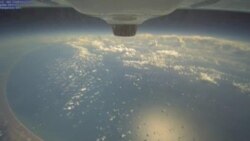GREENBELT, MARYLAND —
The U.S.-based National Oceanic and Atmospheric Administration says this Atlantic hurricane season will likely be even more active than usual. And, as we head into peak hurricane season, the U.S. space agency, NASA, is planning to investigate the tropical storms and hurricanes that churn over the Atlantic Ocean.
Two unmanned Global Hawk aircraft will take to skies above the Atlantic storms and collect measurements so scientists can see how hurricanes evolve. It's the second year of NASA's Hurricane and Severe Storm Sentinel, or HS3, field campaign, says Scott Braun, a research meteorologist at NASA's Goddard Space Flight Center outside Washington.
"What we're really after, scientifically, is to better understand the relative roles of the environment and those inner-core processes in the formation and intensification of hurricanes in the Atlantic," said Braun, the HS3 principal investigator.
High-Flying Hawks
Global Hawks can reach an altitude of almost 20 kilometers, roughly twice as high as a commercial airliner. On-board instruments, such as the High-Altitude Imaging Wind and Rain Profiler, allow scientists to gather details about storms from high above them.
The Global Hawks will monitor the environment near the storms to see how surrounding conditions affect their intensity and also collect data about the storms themselves. One craft will deploy dropsondes, instruments that measure temperature, humidity, pressure, wind speed and wind direction. The dropsondes have parachutes that slow their descent, and Braun says it takes about 20 minutes for them to travel from above the storm down to the surface.
Robotic Craft
The robotic planes in this mission launch from NASA's Wallops Flight Facility in Virginia, on the eastern U.S. coast, and they can fly as far as 20,000 kilometers.
That's just one of the benefits of using this kind of craft, says Braun.
"With the Global Hawk, we can fly for up to about 28 hours, and because all the crew and the scientists are on the ground rather than on the plane, we can swap out shifts," he said. "That just means that you can go much farther or stay out over a storm much longer than you can with a manned aircraft."
Researchers will analyze the data in depth after the field campaign, but Braun says they also plan to do a quick analysis and share some of the information they collect while the Global Hawks are flying over the storms.
Saharan Dust
The HS3 mission also looks into something else that perplexes researchers.
"In addition to wind speed and wind direction, we're also interested in temperature in the environment, particularly in association with something called the Saharan Air Layer," Braun said. "It's a very hot, dry, dusty air mass that comes off Africa."
Last year, the Global Hawks gathered some data about the dust layer that accompanied Tropical Storm Nadine. Scientists debate whether Saharan dust fuels or suppresses the development of tropical storms.
This year's HS3 flights run from August 20 to September 23.
Two unmanned Global Hawk aircraft will take to skies above the Atlantic storms and collect measurements so scientists can see how hurricanes evolve. It's the second year of NASA's Hurricane and Severe Storm Sentinel, or HS3, field campaign, says Scott Braun, a research meteorologist at NASA's Goddard Space Flight Center outside Washington.
"What we're really after, scientifically, is to better understand the relative roles of the environment and those inner-core processes in the formation and intensification of hurricanes in the Atlantic," said Braun, the HS3 principal investigator.
High-Flying Hawks
Global Hawks can reach an altitude of almost 20 kilometers, roughly twice as high as a commercial airliner. On-board instruments, such as the High-Altitude Imaging Wind and Rain Profiler, allow scientists to gather details about storms from high above them.
The Global Hawks will monitor the environment near the storms to see how surrounding conditions affect their intensity and also collect data about the storms themselves. One craft will deploy dropsondes, instruments that measure temperature, humidity, pressure, wind speed and wind direction. The dropsondes have parachutes that slow their descent, and Braun says it takes about 20 minutes for them to travel from above the storm down to the surface.
Robotic Craft
The robotic planes in this mission launch from NASA's Wallops Flight Facility in Virginia, on the eastern U.S. coast, and they can fly as far as 20,000 kilometers.
That's just one of the benefits of using this kind of craft, says Braun.
"With the Global Hawk, we can fly for up to about 28 hours, and because all the crew and the scientists are on the ground rather than on the plane, we can swap out shifts," he said. "That just means that you can go much farther or stay out over a storm much longer than you can with a manned aircraft."
Researchers will analyze the data in depth after the field campaign, but Braun says they also plan to do a quick analysis and share some of the information they collect while the Global Hawks are flying over the storms.
Saharan Dust
The HS3 mission also looks into something else that perplexes researchers.
"In addition to wind speed and wind direction, we're also interested in temperature in the environment, particularly in association with something called the Saharan Air Layer," Braun said. "It's a very hot, dry, dusty air mass that comes off Africa."
Last year, the Global Hawks gathered some data about the dust layer that accompanied Tropical Storm Nadine. Scientists debate whether Saharan dust fuels or suppresses the development of tropical storms.
This year's HS3 flights run from August 20 to September 23.












